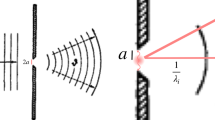Abstract
The notion of microscopic state of the system at a given moment of time as a point in the phase space as well as a notion of trajectory is widely used in classical mechanics. However, it does not have an immediate physical meaning, since arbitrary real numbers are unobservable. This notion leads to the known paradoxes, such as the irreversibility problem. A “functional” formulation of classical mechanics is suggested. The physical meaning is attached in this formulation not to an individual trajectory but only to a “beam” of trajectories, or the distribution function on phase space. The fundamental equation of the microscopic dynamics in the functional approach is not the Newton equation but the Liouville equation for the distribution function of the single particle. The Newton equation in this approach appears as an approximate equation describing the dynamics of the average values and there are corrections to the Newton trajectories. We give a construction of probability density function starting from the directly observable quantities, i.e., the results of measurements, which are rational numbers.
Similar content being viewed by others
References
V. I. Arnold, Mathematical Methods of Classical Mechanics (Springer-Verlag, 1978).
I. V. Volovich, “Number theory as the ultimate physical theory,” preprint, TH 4781/87, CERN, Geneva (1987).
I. V. Volovich, “p-Adic string” Class. Quant. Grav. 4, L83–L87 (1987).
E. I. Zelenov, ”Quantum approximation theorem,” p-Adic Numbers, Ultrametric Analysis and Applications 1(1), 88–90 (2009).
V. S. Vladimirov, I. V. Volovich and E. I. Zelenov, p-Adic Analysis and Mathematical Physics (World Scientific, Singapore, 1994).
A. Yu. Khrennikov, Non-Archimedean Analysis: Quantum Paradoxes, Dynamical Systems and Biological Models (Kluwer Acad. Publishers, Dordrecht, 1997).
B. Dragovich, A. Yu. Khrennikov, S. V. Kozyrev and I.V. Volovich, “On p-adicmathematical physics,” p-Adic Numbers, Ultrametric Analysis and Applications 1(1), 1–17 (2009).
V. S. Varadarajan, “Multipliers for the symmetry groups of p-adic spacetime,” p-Adic Numbers, Ultrametric Analysis and Applications 1(1), 69–78 (2009).
I. V. Volovich, “Time irreversibility problem and functional formulation of classical mechanics,” Vestnik Samara State University 8/1(67), 35–55 (2008); arXiv:0907.2445.
J. R. Taylor, An Introduction to Error Analysis: The Study of Uncertainties in Physical Measurements (University Science Books, 1997).
B. V. Gnedenko, Theory of Probability (Gordon and Breach Science Publishers, Amsterdam, 1997).
I. V. Volovich and A. S. Trushechkin, “Squeezed quantum states on an interval and uncertainty relations for nanoscale systems,” Proc. Steklov Inst.Math. 265, 276–306 (2009).
Author information
Authors and Affiliations
Corresponding author
Additional information
The text was submitted by the authors in English.
Rights and permissions
About this article
Cite this article
Trushechkin, A.S., Volovich, I.V. Functional classical mechanics and rational numbers. P-Adic Num Ultrametr Anal Appl 1, 361–367 (2009). https://doi.org/10.1134/S2070046609040086
Received:
Published:
Issue Date:
DOI: https://doi.org/10.1134/S2070046609040086




